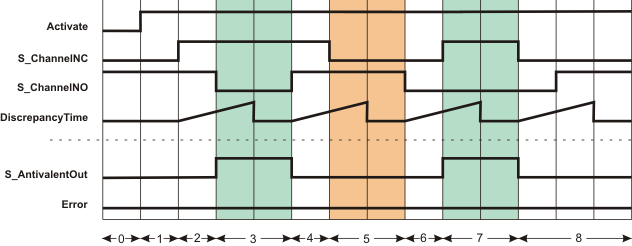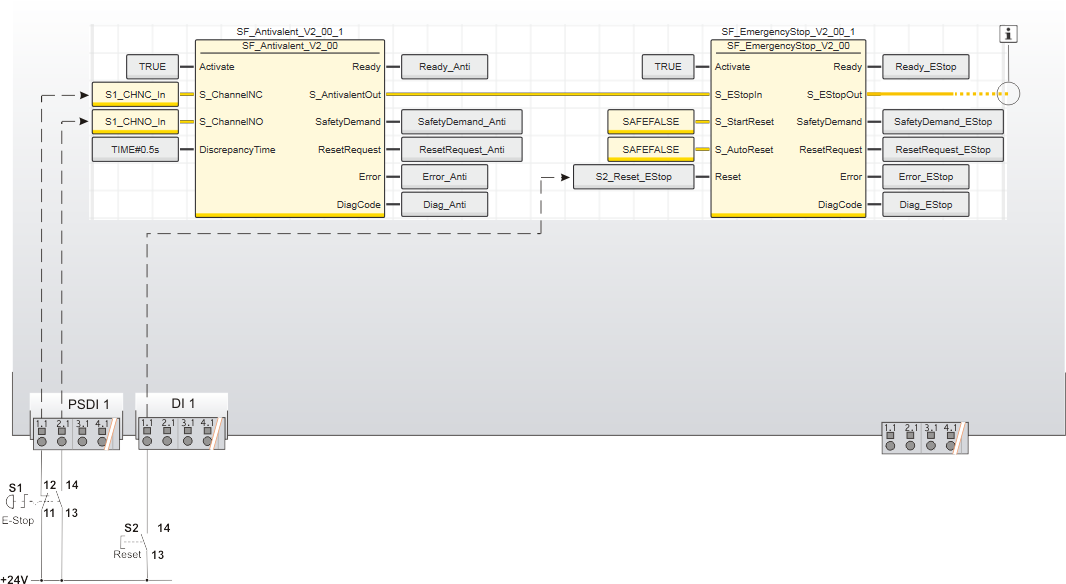SF_Antivalent
Help version 1.1 / Issue date: 2018.03
The following description is valid for the function block SF_Antivalent_V2_0z, Version 2.0z (where z = 0 to 9).
| Short Description | The safety-related SF_Antivalent function block monitors the signals of two safety-related input terminals for different signal states. Typically, these signals come from two-channel sensors or switches such as an emergency-stop control device.The S_AntivalentOut enable signal becomes SAFETRUE when the S_ChannelNC and S_ChannelNO inputs switch as follows within the time set at DiscrepancyTime:
|
|||||||||||||||||||||||||||||
| Block Icon | ||||||||||||||||||||||||||||||
| Inputs |  Activate Activate
Refer to the topic "Activate" for details.  S_ChannelNC S_ChannelNC
Refer to the topic "S_ChannelNC" for details.  S_ChannelNO S_ChannelNO
Refer to the topic "S_ChannelNO" for details.  DiscrepancyTime DiscrepancyTime
Refer to the topic "DiscrepancyTime" for details. |
|||||||||||||||||||||||||||||
| Outputs |  Ready Ready
Refer to the topic "Ready" for details.  S_AntivalentOut S_AntivalentOut
Refer to the topic "S_AntivalentOut" for details.  SafetyDemand SafetyDemand
Refer to the topic "SafetyDemand" for details.  ResetRequest ResetRequest
Refer to the topic "ResetRequest" for details.  Error Error
Refer to the topic "Error" for details.  DiagCode DiagCode
Refer to the topic "DiagCode" for details. |
|||||||||||||||||||||||||||||
| Detailed information |  Signal sequence diagram Signal sequence diagram
The example below shows a typical signal curve, such as may apply to the different signals S_ChannelNC = SAFETRUE and S_ChannelNO = SAFEFALSE within the discrepancy time.
 Application example Application example
This example illustrates two-channel control of the safety-related SF_EmergencyStop function block with the help of the SF_Antivalent function block. The emergency-stop control device is connected to the inputs 1.1 and 2.1 of the safety-related input device PSDI with an ID of 1. The N/C and N/O contacts of the emergency-stop control device are connected to the safety-related SF_Antivalent function block for evaluation purposes. The S_AntivalentOut enable signal of the safety-related SF_Antivalent function block resulting from this is connected to the safety-related SF_EmergencyStop function block for further evaluation. The S_AntivalentOut output of the safety-related SF_Antivalent function block becomes SAFETRUE when the S_ChannelNC and S_ChannelNO inputs switch as follows within the time set at DiscrepancyTime:
A start-up inhibit (after the Safety PLC has been started up or after the function block has been activated) as well as a restart inhibit (after the emergency-stop control device has been deactivated) is set for the safety-related SF_EmergencyStop function block. Both inhibits are removed by pressing the reset button connected to input 1.1 of the standard input device DI with an ID of 1.
 Function block instantiation Function block instantiation
The IEC 61131-3 standard defines function block instantiation. Instantiation means, a function block is defined once and can be used (instantiated) several times. This applies to all FBs (user-defined POUs as well as library FBs, such as IEC standard FBs, firmware FBs, user library FBs).
Why instantiation? The following applies:
The user-defined function block 'TLC' ("Two Level Controller") is added to the 'Functions & Function Blocks' category (COMPONENTS area). It shall be called twice in the program POU 'Container' to control the filling level and the temperature of a boiler. For both FB instances, an instance name declaration is added to the 'Variables' table of the calling program POU 'Container': TLCTemperature and TLCLevel. Thus the 'TLC' function block can be called twice in the code worksheet of the calling POU by means of these instance names. |



